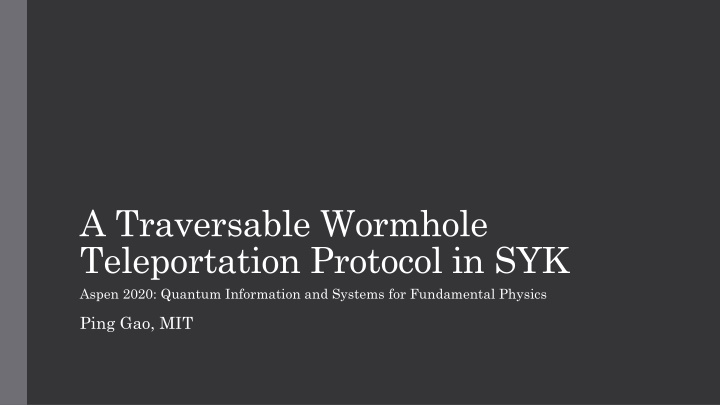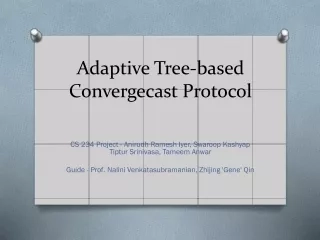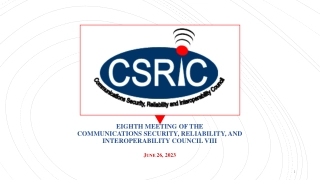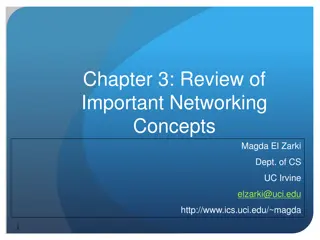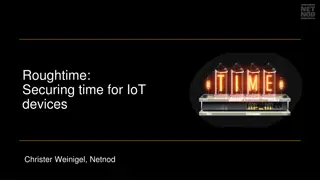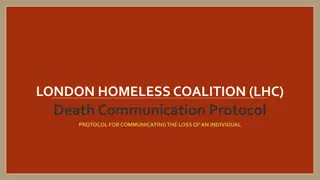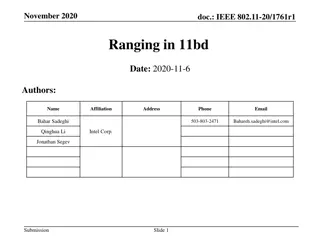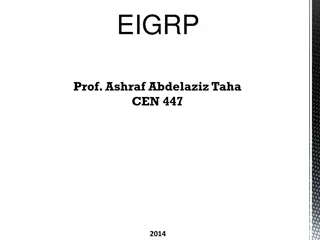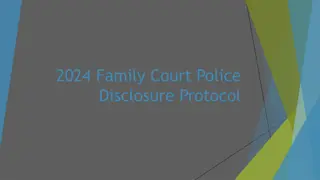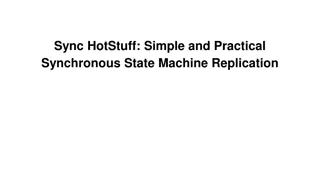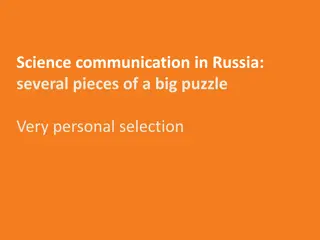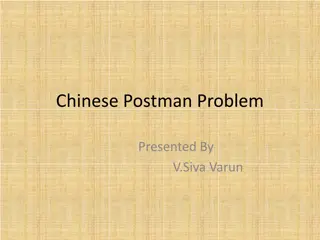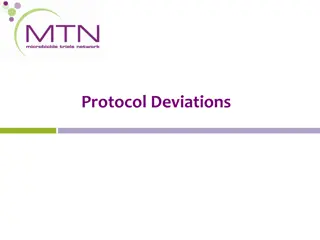A Traversable Wormhole Teleportation Protocol in SYK
Traversable wormholes, connecting different parts of the universe through quantum effects, offer a fascinating avenue for exploring teleportation protocols. This discussion delves into the theoretical underpinnings of wormholes, their generation via quantum phenomena, and the implementation of a qubit-based teleportation model involving gravity features.
Uploaded on Feb 15, 2025 | 1 Views
Download Presentation

Please find below an Image/Link to download the presentation.
The content on the website is provided AS IS for your information and personal use only. It may not be sold, licensed, or shared on other websites without obtaining consent from the author.If you encounter any issues during the download, it is possible that the publisher has removed the file from their server.
You are allowed to download the files provided on this website for personal or commercial use, subject to the condition that they are used lawfully. All files are the property of their respective owners.
The content on the website is provided AS IS for your information and personal use only. It may not be sold, licensed, or shared on other websites without obtaining consent from the author.
E N D
Presentation Transcript
A Traversable Wormhole Teleportation Protocol in SYK Aspen 2020: Quantum Information and Systems for Fundamental Physics Ping Gao, MIT
Outline Review of traversable wormholes Circuit of traversable wormhole teleportation Effectiveness Discussion and conclusion
Traversable wormholes Traversable wormhole is a tunnel in the universe connecting two parts that one can get through in finite time. Its existence requires violation of averaged null energy condition. In other words, it requires negative energy/mass repulsive gravitational force
Traversable wormholes Impossible classically, but can be generated by quantum effect Consider eternal AdS black holes. This are two identical black holes in thermal field double state. ? This state is highly entangled and corresponds to the connected geometry. Two BHs are connected but nontraversable. ? = 0 By AdS/CFT, two CFTs living on the boundaries are entangled and in TFD state. ? Coupling two CFTs by ???????at ? = 0 generates negative energy and make it traversable.
Traversable wormholes Particle (may carry information) gets through from one CFT to the other CFT via the traversable wormhole. ? From boundary point of view, this should be dual to quantum teleportation. Quantum info transmitted. Two CFTs in highly entangled state. Like EPR pair ? = 0 Gravity: coupling ??????? at ? = 0 produces negative energy Boundary: ???????= ???(?? ?)?????? ? measurement unitary classical outcome Same steps of quantum teleportation!
Circuit of traversable wormholes teleportation protocol Question: Can we have a qubit model with gravity feature? Answer: YES! We constructed a simple protocol using SYK model. Why SYK? 1) dual to AdS2 2) Fermion model defining qubits easily Circuit: 5 systems. 1) R, Q and T are 1-qubit site 2) l and r are two SYK model. Each consists N Majorana fermions ??,? ?, namely N/2 qubits In the beginning, R and Q are in |11 )/ 2, T is in |? = ( |00 + 1 N/2 1 1 N/2 |0 ; l and r are in TFD state. |? |??? |0
Circuit of traversable wormholes teleportation protocol The protocol has three steps. 1) SWAP between Q and l at ? . 2) apply ???? at ? = 0; ? = ? ?? 3) SWAP between r and T at ?. (time evolution in l and r is governed by SYK Hamiltonian) ? ??? ? ? = 0 If teleportation succeeds, final mutual information between T and R should be maximal, 2log2. The coupling can be written explicitly as measurement on left with unitary on right acting on each pair of qubits, e.g. 2??? ?? ? ???? 2 + ?? ?? ???? 2?= [??+ 2 ] (at j-th qubit) ??? ??? 1 N/2 1 1 N/2 |? |??? |0
Circuit of traversable wormholes teleportation protocol SWAP: 1) construct Dirac fermions ??,? 2) SWAP between Q and l is ? 1 ? 2? 1+ ???,? 2? = ??,? 2 ? = 0 For ? in 2 by 2 representation, it becomes ordinary SWAP between two qubits. After 3 steps, the state becomes ? To check mutual information between R and T, we calculate reduced density matrix. The matrix elements are correlation functions of these fermions in TFD state. 1 N/2 1 1 N/2 |? |??? |0
Circuit of traversable wormholes teleportation protocol Reduced density matrix ? ? = 0 If MI is maximal (success) we get ? Fermion cannot be created/annihilated twice Left-right causal correlation reaches maximum 1 N/2 1 1 N/2 |? |??? |0
SYK model SYK model has N Majorana fermions with all-to-all q-local coupling in Hamiltonian. The coupling constant is Gaussian random. 0 ?/2 It is maximally chaotic. Low energy effective action is Schwarzian, which can be derived from AdS2 JT gravity. ?? ???? ? ??? ?? Define TFD state with two identical Hailtonian in left and right. 1) Define EPR state between l and r, ?? 2) TFD is Euclidean evolution of total Hamiltonian ?+ ??? ?/4 ? |? = 0 for all ? Correlation function can be understood as Euclidean path integral, e.g.
SYK model 3?/4 Use trick to define a stitching field and combine left and right fermions ? 0 0 ?/2 Define bilinear field G (its vev in TFD state is correlation of fermions) ?/2 ???? ? ??? ? ?? ???? ? ??? ?? Effective action is Large N limit. Equation of motion ?/4 ?/4 Adding the coupling ???? around Euclidean time ?0= ?/4 is equivalent to shift boundary condition of correlation functions
Effectiveness In large q limit, we can solve this twist boundary condition explicitly. Real time correlation is analytic continuation of the Euclidean G, e.g. It turns out that MI ??? only depends on causal correlation function Clearly when ? = 1, MI saturates as 2log2
Effectiveness We take a double limit ? ,?#(?+? )/? fixed. Time scale is ?~????. High T, we have 1. If ?? 0, there is a pole when ? < 0. Required by traversable wormhole! 2. Pole is resolved by numerator ?/?? as a peak. Boundedness required by fermion. 3. ???/??is stringy correction 4. Lyapunov exponent 2?/? in high T 5. There is a transition time ??, insertion before/after it will have different signal ordering. Range preserving ordering is semiclassical. 6. After the peak, , exponential decay of thermalization.
Effectiveness However, the peak is not high enough. It turns out When large q, it is too small to reach maximal MI. But, if we can make ? = 2, |?| = 1 and the teleportation is perfect! 1/? is the conformal weight of Majorana fermion. If we make p fermions together, the weight is ?/?. Then we can choose ? =? effective ? 2 fermion. 2+ 1 to make an Improvement construction: ? 1 in large q limit
Discussion ??? ? couples all fermions between left and right. Partial coupling. ? = ? ?? Indeed, we can couple less. One can choose arbitrary ?? pairs of Majorana fermions to couple for O(1) ?. The protocol still works to maximal MI. Multiple qubits. Here we only consider SWAP in one qubit. But we can duplicate Q and R systems and apply tensor product of SWAPs as long as the their number is o(N). In SYK model, all these SWAPs factorize, and we have independent o(N) channels. Measuring ?? qubits and generating 2?? bits to send o(N) qubit is compatible with standard teleportation inequality 2bits+1EPR 1qubit. Black hole is fastest scrambling system. Gravity is supposed to have features of QEC. This protocol is automatically equipped with QEC as information travels into the interior of black holes and through the traversable wormhole.
Conclusion We proposed a simple teleportation protocol in SYK model. This protocol includes the process of standard teleportation but also shares many common feature as traversable wormholes. It requires 3 steps: 1) SWAP-in at early time; 2) weak coupling; 3) SWAP-out at later time. Time scale is ?~????. In low T, it matches with semiclassical gravity. 1) peak; 2) signal ordering preserved. It can be improved to get maximal fidelity by encoding the qubit into ? =? 1 Majorana fermions. 2+
